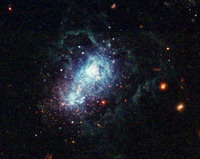Scientists discover young galaxies
The scientists managed to discover young galaxies by aiming two of the world's most powerful telescopes at a single patch of sky for a combined total of nearly 100 hours.

An international group of researchers has identified 27 pre-galactic fragments, dubbed "teenager galaxies," which they hope will help astronomers understand how our own Milky Way reached adulthood.
Cambridge University scientist Martin Haehnelt said his team used the European Southern Observatory's Very Large Telescope and the Gemini Telescope in Chile to monitor a section of the Universe for 92 hours - the equivalent of 12 complete nights.
"The process was a bit like taking a photograph and keeping the shutter open for a very long time," Haehnelt said. "If you expose the image for long enough you see fainter objects, such as these proto-galaxies. We took the largest telescope we could and stared through it for as long as we were allowed."
Light takes time to travel across the universe, and powerful telescopes can pick up light which reaches them from extremely far back in time. In this case, the ultra-long exposure technique allowed scientists to see back 11 billion years or more - to 2 billion years after the Big Bang - when galaxies were still forming.
Scientists said the scope of the discovery was unprecedented.
"This is the first time that we've gone deep enough to detect the first building blocks of galaxies," said Richard McMahon, an astronomer at Cambridge University who was not involved in the research but has carried out similar work. He added that the fragments discovered were so young they might more appropriately be called "baby galaxies."
Whether babies or teens, the clusters make a compelling case for the theory that galaxies formed bit by bit instead of all at once, said Carlos Frenk, a cosmologist at Durham University in northern England who did not participate in the survey.
Frenk said astronomers had been guessing for the past 20 to 30 years at how galaxies formed, with some theoreticians arguing they were made from the amalgamation of smaller pre-galactic fragments.
"I'm very excited, because it's the first time that these fragments are unambiguously detected with the masses we would expect," he said. "What this work shows is: The universe is just as the doctor ordered."
Securing permission to use the telescopes was not easy. It took Haehnelt and his colleagues five years to convince the telescopes' managers to give them the chunk of time they needed to run their study, he said. It took another two years to gather the data, with scientists taking readings for one hour here, another hour there. The images were later superimposed electronically to create the full picture.
Haehnelt said he picked a patch of sky where previous observations had suggested the teenage galaxies could be found. "If we hadn't found anything special we would have had to explain why we were wasting valuable time and resources," he said.
Researchers were able to identify the fragments from the weak light they emitted. Analysis of the light pointed to low star formation rates and low levels of chemical enrichment, suggesting the objects were an early stage of formation.
Haehnelt said that larger, brighter galactic fragments had been spotted before and that they would go on to form much larger galaxies than the Milky Way. The adolescents identified by his team, in contrast, would later grow into galaxies much like the one we inhabit.
Haehnelt's team included Michael Rauch and George Becker from the Observatories of the Carnegie Institution, and Andy Bunker of the Anglo-Australian Observatory.
Their findings are due to be published in the March 2008 issue of the Astrophysical Journal.
Subscribe to Pravda.Ru Telegram channel, Facebook, RSS!





